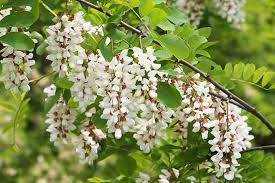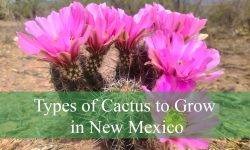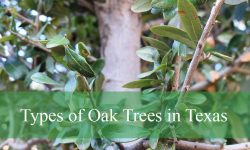Most types of locust trees are popular among gardeners and landscape enthusiasts due to their beauty, durability, and versatility. These trees can also adapt to different climates in North America and other parts of Europe.
Telling the differences between different kinds of locust trees can be a daunting experience for novices or beginners. I wrote this comprehensive guide to help you explore different types of locust trees by highlighting their unique characteristics and benefits.
How to Identify Locust Trees (Identification Tips)
Locust trees have become a staple in parks, streetscapes, and home gardens. I recommend using flowers, bark colors, tree height, and thorns to identify the exact locust tree species. You can also use the seed pods’ shape and color to differentiate those species with close similarities.
Locust Tree Leaves
These trees have compound leaves with each leaf consisting of multiple leaflets. The leaflets are usually small and oval-shaped with arrangement on the central stem varying from one species to another.
Locust Tree Thorny Branches
Most locust trees have sharp thorns that grow up to 3-10cm long. These sharp spikes grow singularly or on thorned branches. They can easily injure your skin since they are robust and tough.
Locust Tree Bark
A mature locust tree has a deeply furrowed and rough textured bark. The color may vary from gray to brown or even reddish-brown.
Locust Tree Flowers
Locust tree flowers are prominent features due to their conspicuous colors. The flower colors can be white, pink, or yellow depending on the species.
Different Types of Locust Trees (With Pictures)
Locust trees are native to North America, but they can grow in different countries due to their ability to adapt to different climates. Here is a detailed list of various kinds of locust trees:
Black Locust (Robinia pseudoacacia)

Black Locust (Robinia pseudoacacia) is a deciduous tree native to North America. It is known for its rapid growth, hardiness, and nitrogen-fixing abilities. The tree typically reaches a height of 40-100 feet (12-30 meters) with a spread of 30-50 feet (9-15 meters).
Black Locust has distinctive compound leaves consisting of 9-19 leaflets, which turn yellow in the fall. Its fragrant white flowers appear in late spring or early summer, growing in clusters known as racemes. These flowers are a valuable source of nectar for bees and other pollinators.
The wood of Black Locust is exceptionally strong, durable, and resistant to rot and decay. It is commonly used for outdoor applications such as fencing, posts, decking, and furniture. The tree also has ecological benefits as it enriches the soil with nitrogen through its root nodules, making it suitable for soil reclamation and erosion control.
Black Locusts can become invasive in some areas outside their native range from Europe to Asia. It has a tendency to spread aggressively and can outcompete native vegetation, reducing biodiversity.
Honey Locust (Gleditsia triacanthos)
Honey Locust (Gleditsia triacanthos) is a deciduous tree native to eastern North America. It is known for its attractive appearance, adaptable nature, and the sweet nectar-like substance found in its seed pods. The tree typically grows to a height of 30-70 feet (9-21 meters) with a spread of 30-50 feet (9-15 meters).
Honey Locust has pinnately compound leaves that consist of numerous leaflets. These leaves provide a dappled shade due to their fine texture, making them a popular choice for landscaping. In the fall, the leaves turn a vibrant yellow before dropping.
The tree produces small greenish-yellow flowers in late spring, which are inconspicuous but attract bees and other pollinators. The female trees bear long, twisted, and flat seed pods in the late summer or fall. These pods contain a sweet, edible pulp that is consumed by various wildlife, including deer and birds.
Honey Locust is highly adaptable to different soil conditions and can tolerate both drought and pollution. It is often planted as a shade tree in parks, along streets, and in urban landscapes. The wood of Honey Locust is hard and durable, making it suitable for various applications such as furniture, flooring, and fence posts.
However, it’s important to note that some cultivars of Honey Locust, particularly thornless varieties, have been developed to eliminate the thorns found on the branches, making them more suitable for areas where thorns may be a concern.
Honey Locust is a versatile tree with attractive foliage, sweet seed pods, and adaptability to different environments. It is commonly used for landscaping and provides habitat and food for wildlife.
New Mexico Locust (Robinia neomexicana)
New Mexico Locust (Robinia neomexicana) is a small to medium-sized deciduous tree native to the southwestern United States, particularly in the states of New Mexico and Arizona. It belongs to the same genus as the Black Locust (Robinia pseudoacacia) but has some distinguishing features.
New Mexico Locust typically grows to a height of 15-30 feet (4.5-9 meters) with a spread of 15-20 feet (4.5-6 meters). It has a compact, rounded crown with branches that often droop slightly. The tree has bipinnately compound leaves, meaning each leaf is divided into smaller leaflets, giving it a delicate and feathery appearance.
The leaves of New Mexico Locusts are a bluish-green color and turn yellow in the fall, adding seasonal interest to landscapes. In early summer, the tree produces showy, fragrant clusters of white flowers, which are attractive to bees and butterflies.
One notable characteristic of the New Mexico Locust is its thorny branches, which are covered in sharp spines. These thorns provide the tree with protection against browsing animals.
The wood of New Mexico Locust is strong and durable, making it suitable for a variety of uses, including fence posts, poles, and furniture. Their smaller size and thorny branches make it less commonly used for commercial purposes compared to their cousin, the Black Locust.
New Mexico Locust is well-adapted to arid and semi-arid environments, tolerating drought and poor soil conditions. It is often found growing in rocky slopes, canyons, and arroyos. The tree plays a role in stabilizing soil and preventing erosion in these habitats.
New Mexico Locust is a small, thorny tree native to the southwestern United States. It features attractive foliage, fragrant flowers, and strong wood. Its adaptability to arid conditions makes it a valuable component of desert and xeriscape landscapes.
Chinese Locust (Robinia pseudoacacia ‘Decaisneana’)
Chinese Locust (Robinia pseudoacacia ‘Decaisneana’), also known as Bristly Locust or Fernleaf Locust, is a cultivar of the Black Locust tree (Robinia pseudoacacia). It is a deciduous tree that originated in China and has been widely cultivated for its unique foliage and ornamental value.
Chinese Locust typically grows to a height of 30-50 feet (9-15 meters) with a spread of 20-35 feet (6-10.5 meters). It has a moderate growth rate and forms an upright, vase-shaped crown. The tree’s most distinctive feature is its fern-like compound leaves, which are finely divided into numerous small leaflets. This delicate and lacy foliage gives the tree an elegant and airy appearance.
During late spring or early summer, Chinese Locust produces clusters of fragrant, white flowers that attract pollinators such as bees and butterflies. These flowers are followed by long, flat seed pods that contain small brown seeds.
Chinese Locust is valued for its adaptability to a wide range of soil types and its tolerance to urban conditions, including pollution and compacted soil. It is often used as a shade tree in urban landscapes, parks, and along streets. The dense foliage provides shade during the summer months, and the yellow fall color adds to its visual appeal.
Unlike the thorny branches of the common Black Locust, the Chinese Locust has fewer or no thorns, making it more suitable for areas where thorns may be a concern.
It’s important to note that while the Chinese Locust is known for its ornamental value, it can also be invasive in some regions outside its native range. Care should be taken to prevent its spread into natural areas where it can outcompete native vegetation.
The Chinese Locust is a cultivated variety of the Black Locust tree, prized for its fern-like foliage, fragrant flowers, and adaptability to various soil and urban conditions. It serves as an attractive shade tree but should be monitored to prevent potential invasiveness.
Golden Locust (Robinia pseudoacacia ‘Frisia’)
Golden Locust (Robinia pseudoacacia ‘Frisia’) is a popular cultivar of the Black Locust tree (Robinia pseudoacacia). It is known for its striking golden-yellow foliage, which adds vibrant color and visual interest to landscapes.
Golden Locust typically grows to a height of 30-50 feet (9-15 meters) with a spread of 20-35 feet (6-10.5 meters). It has a relatively fast growth rate and forms an upright, vase-shaped crown. The tree’s most notable feature is its foliage, which emerges as bright golden-yellow in spring and retains its color throughout the summer. In the fall, the leaves transition to a warm golden or orange hue before dropping.
This cultivar of Black Locust also produces clusters of fragrant white flowers in late spring or early summer. These flowers attract pollinators such as bees and butterflies. Following the flowering period, long, flat seed pods develop on the tree, containing small brown seeds.
Golden Locust is tolerant of a wide range of soil types and environmental conditions. It is commonly used as an ornamental tree in gardens, parks, and urban landscapes, where its vibrant foliage adds a touch of color and contrast. Its upright form and bright foliage make it an excellent choice as a focal point or specimen tree.
It’s important to note that while Golden Locust is prized for its aesthetic appeal, the Black Locust species, including this cultivar, can have invasive tendencies in some regions outside its native range. Care should be taken to prevent the tree from spreading and out-competing native vegetation.
Golden Locust is a cultivated variety of the Black Locust tree, valued for its vibrant golden-yellow foliage and adaptability to various soil and environmental conditions. It serves as an attractive ornamental tree but should be monitored to prevent potential invasiveness.
Twisty Baby Locust (Robinia pseudoacacia ‘Lace Lady’)
Twisty Baby Locust (Robinia pseudoacacia ‘Lace Lady’) is a unique and compact cultivar of the Black Locust tree (Robinia pseudoacacia). It is highly valued for its distinctive contorted branches and delicate foliage, which give it an intriguing and ornamental appearance.
Twisty Baby Locust typically grows to a smaller size compared to other Black Locust varieties, reaching a height of around 10-15 feet (3-4.5 meters) with a spread of 6-8 feet (1.8-2.4 meters). It has a slow growth rate and forms a dense, rounded crown. The most striking feature of this cultivar is its twisted and gnarled branches, which create a visually appealing architectural form even during the winter months.
The foliage of Twisty Baby Locust consists of pinnately compound leaves with numerous small leaflets. The leaves emerge as a vibrant green color in spring, turning yellow in the fall before dropping. While the flowers of this cultivar are less showy than some other Black Locust varieties, they still produce small, fragrant white blossoms in late spring.
Due to its compact size and unique branching pattern, Twisty Baby Locust is well-suited for smaller gardens, urban landscapes, and container planting. Its unusual form and attractive foliage make it an eye-catching accent tree or focal point in the landscape.
As with other Black Locust trees, Twisty Baby Locust is tolerant of different soil conditions and is relatively drought-resistant once established. However, it’s important to note that the species has invasive potential in some regions outside its native range, and proper care should be taken to prevent its spread.
Twisty Baby Locust is a compact cultivar of the Black Locust tree, prized for its contorted branches and delicate foliage. It is an excellent choice for smaller landscapes, adding visual interest and a touch of uniqueness to gardens or urban settings.
Bristle Locust (Robinia hispida)
Bristle Locust (Robinia hispida), also known as Rose Acacia or Bristly Locust, is a deciduous shrub native to the southeastern United States. It is a member of the Robinia genus, which includes the Black Locust tree.
Bristle Locust typically grows as a multi-stemmed shrub, reaching a height of 6-10 feet (1.8-3 meters) with a similar spread. It has a spreading and arching growth habit with thorny branches covered in bristly hairs, hence its common name. The thorns on the branches serve as a deterrent to browsing animals.
The shrub produces attractive compound leaves that consist of oval-shaped leaflets. The foliage is a dark green color and provides a lush appearance. In early summer, Bristle Locust bears clusters of fragrant, pink to purplish-pink flowers. These flowers resemble pea-like blossoms and are a favorite of bees and butterflies.
Following the flowering period, small flattened seed pods develop on the shrub. These pods contain pea-sized seeds and persist into the fall, providing visual interest and a food source for wildlife.
Bristle Locust is known for its adaptability to various soil types and its tolerance to drought. It can thrive in full sun to partial shade, making it suitable for a range of garden and landscape settings. The shrub is often utilized as a hedge, border plant, or as part of naturalized areas.
It’s important to note that while Bristle Locust is not as invasive as the Black Locust, it can spread through suckering, forming dense thickets. Regular pruning can help manage its growth and prevent it from becoming overly aggressive.
Bristle Locust is a thorny shrub with attractive foliage and showy pink flowers. It adapts well to different soil conditions and is valued for its ornamental qualities. Care should be taken to control its spread through regular maintenance.
Purple Robe Locust Tree (Robinia pseudoacacia)
The Purple Robe Locust Tree (Robinia pseudoacacia ‘Purple Robe’) is a deciduous tree known for its stunning purple flowers and graceful form. It is a cultivar of the Black Locust tree (Robinia pseudoacacia) and is valued for its ornamental appeal.
The Purple Robe Locust typically grows to a height of 30-40 feet (9-12 meters) with a spread of 20-35 feet (6-10.5 meters). It has an upright, vase-shaped crown and a moderate growth rate. The tree’s most notable feature is its abundant and showy clusters of fragrant, deep purple flowers. These flowers bloom in late spring or early summer, creating a striking contrast against the tree’s green foliage.
The foliage of the Purple Robe Locust consists of pinnately compound leaves with numerous leaflets. The leaves are typically medium green in color and turn yellow in the fall, adding to the tree’s seasonal interest.
In addition to its beautiful flowers and foliage, the Purple Robe Locust also has attractive, textured bark that adds visual appeal. The bark is grayish-brown and develops furrows and ridges as the tree matures.
Like other Black Locust trees, the Purple Robe Locust is known for its tolerance to a wide range of soil types and its ability to withstand drought and urban conditions. It is often used as an ornamental tree in landscapes, parks, and along streets. The Purple Robe Locust can serve as a focal point, providing a burst of vibrant color and a graceful silhouette.
It’s important to note that while the Purple Robe Locust is a cultivated variety and valued for its ornamental features, the Black Locust species, including this cultivar, can be invasive in some regions outside its native range. Proper care should be taken to prevent the tree from spreading and out-competing native vegetation.
The Purple Robe Locust Tree is a cultivar of the Black Locust known for its captivating purple flowers, graceful form, and adaptable nature. It adds a touch of beauty and elegance to landscapes, making it a popular choice for ornamental planting.
Imperial Honey Locust Tree (Gleditsia triacanthos f. inermis ‘Impcole’)
The Imperial Honey Locust Tree (Gleditsia triacanthos f. inermis ‘Impcole’) is a cultivated variety of the Honey Locust tree (Gleditsia triacanthos). It is highly regarded for its graceful form, attractive foliage, and thornless nature, making it a popular choice for landscaping.
The Imperial Honey Locust typically grows to a height of 30-50 feet (9-15 meters) with a spread of 30-40 feet (9-12 meters). It has a rounded, spreading crown and a moderate growth rate. One of its most notable features is its fern-like leaves, which provide dappled shade due to their fine texture.
The foliage of the Imperial Honey Locust consists of pinnately compound leaves with numerous small leaflets. The leaflets emerge as a vibrant green color in spring, turning a golden yellow in the fall, creating a stunning display of autumn color.
Unlike the standard Honey Locust, which has sharp thorns on its branches, the Imperial Honey Locust is a thornless variety, making it more suitable for areas where thorns may pose a concern, such as parks, playgrounds, and residential landscapes.
In addition to its aesthetic appeal, the Imperial Honey Locust is highly adaptable to various soil types and can tolerate drought and pollution. It is commonly planted as a shade tree in urban environments and along streets. The tree’s ability to withstand urban conditions makes it a valuable asset in landscaping projects.
It’s important to note that the Imperial Honey Locust is a male cultivar, meaning it does not produce the seed pods found on female Honey Locust trees. This can be advantageous in landscape settings where the potential mess from seed pods is a concern.
The Imperial Honey Locust Tree is a cultivated variety of the Honey Locust known for its graceful form, fine-textured foliage, and thornless branches. It provides attractive shade and is well-suited for urban landscapes, parks, and residential areas.
Skyline Honey Locust Tree (Gleditsia triacanthos ‘Skycole’)
The Skyline Honey Locust Tree (Gleditsia triacanthos ‘Skycole’) is a cultivated variety of the Honey Locust tree (Gleditsia triacanthos) known for its distinctive upright form and finely-textured foliage. It is a popular choice for landscaping due to its attractive appearance and adaptability to various environments.
The Skyline Honey Locust typically grows to a height of 40-60 feet (12-18 meters) with a spread of 30-40 feet (9-12 meters). It has a narrow, columnar shape with ascending branches, creating a tall and slender silhouette. This upright habit makes it a suitable choice for areas with limited space or when a vertical accent is desired in the landscape.
The foliage of the Skyline Honey Locust consists of pinnately compound leaves with numerous small leaflets. The leaflets are finely divided, giving the tree a delicate and airy appearance. The leaves emerge as a bright green color in spring, transitioning to a golden yellow in the fall, adding a touch of seasonal interest to the landscape.
One of the notable characteristics of the Skyline Honey Locust is its ability to cast light, filtered shade due to its finely-textured foliage. This makes it a desirable tree for areas where a more open canopy is preferred, allowing for the growth of grass or other plants beneath it.
The Skyline Honey Locust is adaptable to a variety of soil types and can tolerate drought and urban conditions, making it suitable for a range of landscapes. It is commonly planted as a shade tree in urban areas, parks, and along streets, providing an elegant vertical element to the surroundings.
It’s important to note that the Skyline Honey Locust is a thornless variety, lacking the sharp thorns typically found on some other Honey Locust trees. This makes it more desirable for areas where thorns may pose a concern, such as parks, playgrounds, and residential landscapes.
The Skyline Honey Locust Tree is a cultivated variety of the Honey Locust known for its upright form, finely-textured foliage, and adaptability to different environments. It adds vertical interest to landscapes and provides filtered shade, making it a popular choice for urban areas, parks, and residential settings.
Sunburst Honey Locust Tree (Gleditsia triacanthos var. inermis ‘Suncole’)
The Sunburst Honey Locust Tree (Gleditsia triacanthos var. inermis ‘Suncole’) is a cultivated variety of the Honey Locust tree (Gleditsia triacanthos). It is highly valued for its vibrant golden foliage, graceful form, and thornless branches, making it a popular choice for landscaping.
The Sunburst Honey Locust typically grows to a height of 30-40 feet (9-12 meters) with a spread of 25-35 feet (7.5-10.5 meters). It has an open, spreading crown with a rounded silhouette. The tree’s most striking feature is its foliage, which emerges as a brilliant yellow or golden color in spring and retains its vibrant hue throughout the summer. This golden foliage adds a burst of color and visual interest to the landscape.
The leaves of the Sunburst Honey Locust are pinnately compound, consisting of numerous small leaflets. The fine-textured foliage creates a delicate and airy appearance. In the fall, the leaves transition to a warm yellow or golden color, adding to the tree’s seasonal beauty.
Unlike the standard Honey Locust, which has sharp thorns on its branches, the Sunburst Honey Locust is a thornless variety, making it more suitable for areas where thorns may pose a concern, such as parks, playgrounds, and residential landscapes.
In addition to its striking foliage, the Sunburst Honey Locust is adaptable to various soil types and can tolerate drought and urban conditions. It is commonly planted as a shade tree in urban environments, parks, and along streets. The tree’s ability to withstand urban conditions makes it a valuable asset in landscaping projects.
It’s important to note that the Sunburst Honey Locust is a male cultivar, meaning it does not produce the seed pods found on female Honey Locust trees. This can be advantageous in landscape settings where the potential mess from seed pods is a concern.
The Sunburst Honey Locust Tree is a cultivated variety of the Honey Locust known for its vibrant golden foliage, graceful form, and thornless branches. It provides beautiful shade and is well-suited for urban landscapes, parks, and residential areas, adding a touch of color and elegance to the surroundings.
African Locust Bean (Parkia biglobosa)
The African Locust Bean is a tree species native to the African continent. It is also commonly referred to as the African locust bean tree, néré tree, or African mesquite. This versatile tree is highly valued for its nutritious fruits, seeds, and other useful parts.
The African Locust Bean tree typically grows to a height of 15-25 meters (50-80 feet) and has a spreading crown with dense foliage of pinnately compound leaves. The leaves are dark green in color and provide shade beneath the tree’s canopy.
One of the most significant features of the African Locust Bean is its fruit. The fruit is a long, twisted, and leathery pod that can grow up to 50 centimeters (20 inches) in length. Inside the pod, there are edible seeds embedded in a sweet, yellowish pulp. These seeds and pulp are commonly used in African cuisine, particularly in traditional dishes and condiments.
The seeds of the African Locust Bean, known as locust beans or Dawa Dawa, have a distinctive flavor and aroma. They are often fermented and used as a seasoning or condiment in soups, stews, and sauces. The fermented seeds are rich in protein, carbohydrates, and essential minerals, making them a valuable food source and an important part of local diets.
Apart from its culinary uses, various parts of the African Locust Bean tree have medicinal and industrial applications. The bark, leaves, and roots of the tree are used in traditional medicine to treat ailments such as diarrhea, malaria, and respiratory problems. The wood of the tree is durable and used for construction, furniture making, and fuelwood.
The African Locust Bean tree is well-adapted to arid and semi-arid environments, making it an important tree for agroforestry and land restoration projects. Its deep roots help improve soil fertility, and it has nitrogen-fixing properties that benefit other plants growing nearby.
The African Locust Bean is a valuable tree native to Africa. It is prized for its nutritious fruits and seeds, which are used in cooking, and its various other useful applications in traditional medicine and industry. This tree plays a significant role in local food security, cultural practices, and environmental sustainability.
Final Thoughts From Experts
Locust trees encompass a diverse array of species and cultivars, each with its own unique features and benefits. From the fast-growing black locust to the ornamental honey locust and the arid-climate-adapted New Mexico locust, there is a locust tree suitable for every garden or landscape setting.
Whether you seek shade, erosion control, or simply an aesthetically pleasing addition to your outdoor space, locust trees offer a versatile and attractive option. Consider incorporating one of these captivating trees into your landscape design to enjoy their beauty and resilience for years to come.
People Who Read This Also Read:






